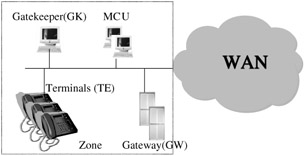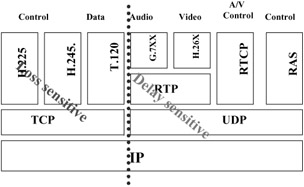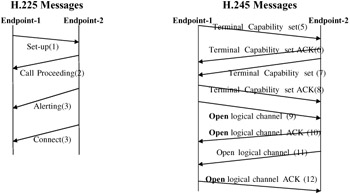7.5 Overview of the H.323 Protocol
7.5 Overview of the H.323 Protocol
This section presents a brief introduction to the H.323 and RTP/RTCP [22] protocols. The H.323 standard provides a foundation for audio, video, and data communications across IP-based networks for multimedia communications over LAN with no QoS guarantee. The standard is broad in scope and includes both stand-alone devices, embedded personal computer technology, and point-to-point and point-to-multipoint conferences. The standard specifies the interfaces between LANs and other networks, and addresses call control, multimedia management, and bandwidth management methods. It uses the concept of channels to structure information exchange between the communications entities. A channel is a transport layer connection (unidirectional or bidirectional).
The Real-Time Transport Protocol (RTP) is used in conjunction with H.323 to provide end-to-end data delivery services with real-time characteristics. RTP can handle interactive audio and video services over a connectionless network. At present, RTP/RTCP (Real-Time Control Protocol) along with UDP provides the bare-bones real-time services capability to IP networks with minimum reliability. A typical H.323 network, shown in Figure 7.3, consists of a number of zones interconnected by a wide area network (WAN). The four major components of a zone are terminals, gateways (GW), gatekeepers (GK) and multipoint control units (MCU). An H.323 terminal is the client and endpoint for real-time, two-way communications with other terminals, GWs, or MCUs. The (optional) GK provides address translation-and-controls access and bandwidth-management functions to the H.323 network. The GW is an endpoint that interconnects the VoIP terminal to the PSTN network. The MCU is the network endpoint for multipoint conferencing. An H.323 communication includes controls, indications, and media packets of audio, moving color video pictures, and data. Thus, H.323 is a protocol suite, as shown in Figure 7.4, which includes separate protocol stacks for control and media packet transport. All H.323 terminals must support the H.245 protocol, which is used to negotiate channel usage and capabilities. Three additional components are required in the architecture:

Figure 7.3: H.323 system components.

Figure 7.4: H.323 protocol relationships.
-
H.225 for call signaling and call setup (a variation of Q.931)
-
Registration/admission/status (RAS) protocol for communicating with a gatekeeper
-
RTP/RTCP for sequencing audio and video packets
A typical H.323 call setup is a three-step process that involves call signaling, establishing a communication channel for signaling, and establishing media channels. In the first phase of call signaling, the H.323 client requests permission from the (optional) gatekeeper to communicate with the network. Once the call is admitted, the rest of the call signaling will proceed according to one of several call models. Figure 7.5 describes the message flows in H.225 and H.245, where Endpoint-1 is the calling endpoint and Endpoint-2 is the called endpoint.

Figure 7.5: H.323 messages.
In the direct routing call model, the two endpoints communicate directly instead of registering with a gatekeeper. As shown in Figure 7.5, Endpoint-1 (the calling endpoint) sends the H.225 setup (1) message to the well-known call signaling channel transport identifier of Endpoint-2 (the called endpoint), which responds with the H.225 connect (3) message. The connect message contains an H.245 control channel transport address for use in H.245 signaling. The H.225 call proceeding (2) message is optional. Once the H.245 control channel (unidirectional) is established, the procedures for capability exchange and opening media channels are used, as shown in Figure 7.5. The first H.245 message to be sent in either direction is terminal capability set (5 and 7), which is acknowledged by the terminal capability set ACK (6 and 8) message. There can be an optional master-slave determination procedure invoked at this stage to resolve conflicts between the two endpoints trying to open a bidirectional channel. The procedures of H.245 are used to open logical channels for the various information streams (9 and 11). The open logical channel ACK (10 and 12) message returns the transport address that the receiving end has assigned to the logical channel. Both the H.225 and H.245 messages are transmitted over a reliable transport layer.
After the media channel has been set up and RTCP CNAMEs (canonical name) are exchanged, two TCP sessions are established, one for H.225 and the other for H.245 procedures, so that multiple media streams (e.g., audio and video) to the same user can be synchronized. [23] The setup delay is very large in H.323 for a regular call, which involves multiple messages from its underlying protocols such as H.225 and H.245. This delay is rather prominent on a low-bandwidth, high-loss environment. It is further aggravated by the higher delay margin on wireless access links. The fast call setup method is an option specified in H.323 that reduces the delay involved in establishing a call and initial media streams.
[22]Schulzrinne, H. et al., RTP: A Transport Protocol for Real-Time Applications, RFC 1889, IETF, Jan. 1996.
[23]Schulzrinne, H. et al., RTP: A Transport Protocol for Real-Time Applications, RFC 1889, IETF, Jan. 1996.
EAN: 2147483647
Pages: 239